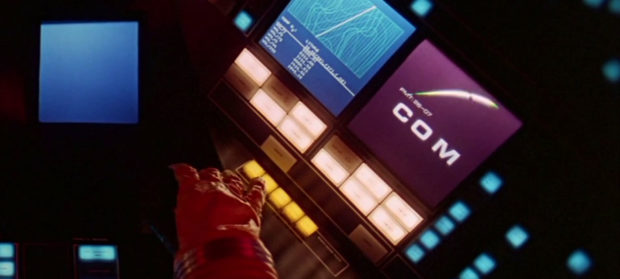An iconographic and text archive related to communication, technology and art.
☛ Detail of a snapshot from Stanley Kubrick’s 2001: A Space Odyssey (UK/USA, 1968) showing a bright scratch across the “COM” computer display. Warner 2007 Blu-ray edition @01:31:13
• • •
- Takeaway
- Summary
- Where are the scratches in 2001: A Space Odyssey?
- Which edition of 2001: A Space Odyssey feature the scratches?
- About computer readouts in 2001: A Space Odyssey
- References
- Additional materials
• • •
Takeaway
There is a set of scratches in 2001: A Space Odyssey that are not on the film, but in the film. They were filmed during production, in 1965 or 1966, visible at the same moments and locations within the frame in most copies of the movie, from VHS and Blu-ray releases to 70 mm and IMAX prints. It remains unknown if they were visible during the film’s premiere in April 1968.
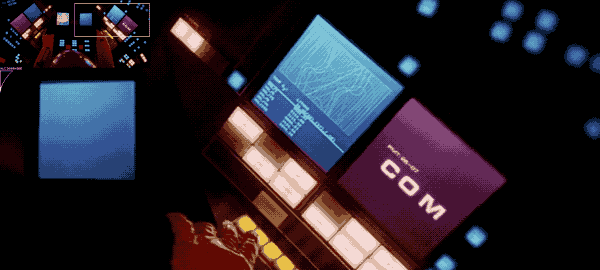
Summary
Animated snapshots of the set of scratches are shown above. They are not the only scratches visible in the movie, but by far are the easiest to spot. They flash by the dark purple “COM” label on one of the EVA pod’s many computer screens. These scratches did not appear on a specific release of the film. Rather, they occurred on one of the many 16 mm loops of celluloid film used in rear projection to fill the computer screens with a variety of readouts. The scratches were part of the set pieces, filmed during production. This makes it possible to observe the same set of scratches at the same moments and in the same position within the frame in various editions of 2001: A Space Odyssey.
In fact, they should be visible on all available copies, with two notable exceptions. This specific set of scratches is absent from versions of the movie where the sides of the film were cropped to fit television screens. Indeed, they only occur when the “COM” computer display is positioned on the far right side of the 2.20:1 frame. They are also absent from later editions of the film where they may have been digitally erased or cleaned. Their absence alone is not a proof of digital cleaning, but it represents a likely and partly supported explanation.
The specific snapshots featured above were taken from Warner’s 2007 Blu-ray edition of 2001: A Space Odyssey. The same scratches can also be observed in a number of additional releases, including VHS and DVD editions, which I have listed in a table below. Interestingly, they are also visible on the “unrestored” 70 mm print launched at Cannes in May 2018. Each time, the set of scratches occurs at the same place, at the same moments. They only flash by when the “COM” logo appears (although not every time), and always in scenes featuring interior shots of the EVA pod’s computers.
In the following research notes, I first describe when the scratches occur in the film. Then I examine various editions of 2001: A Space Odyssey, and list which carry the scratches. Finally, I provide technical information to explain how the animated readouts filling the many computer screens on the set were made.
Where are the scratches in 2001: A Space Odyssey?
Although I’ve viewed 2001: A Space Odyssey a number of times over the years in a variety of formats, I only became aware of this set of scratches during a screening of the “unrestored” 70 mm print at TIFF Bell Lightbox in Toronto, in June 2018. This was the first time I saw the same scratches in two different scenes, each time with similar (if flashing) shapes, and each time at the very same position on the set (i.e. within the “COM” computer screen). It was clear the scratches were not on the 70 mm print showing that afternoon, but in the film itself, meaning they were likely visible on other copies of the film. Once I started checking different editions of 2001: A Space Odyssey, I noticed many featured the same set of scratches a total of 4 times. Each time, the scratches share the following similarities:
- The “COM” label can be seen in different spacecraft, but is most prominently featured during the “Jupiter Mission” segment. During this segment, it is visible on many occasions (I counted over 30) and in different locations inside the Discovery. However, the set of scratches is only visible in scenes featuring the interior of the EVA pods;
- As mentioned, they always occur at the same place, on a computer display labeled “COM,” and only when this three-letter label is being displayed;
- In the film, the “COM” computer display shows a variety of datasets and graphs. However, the scratches always appear when the “COM” logo replaces a readout sequence involving a zooming and then blinking wave-like graph.
The fact that the scratches always appear within the confines of one of the computer displays indicates they occurred on one of the many 16 mm loops used in rear projection to fill the screens with animated readouts. Because of the color of the scratches, it is possible to infer they occurred on the emulsion side of the 16 mm film (I will explore how these readouts were produced below). Finally, there are shots featuring the blinking, wave-like graph being replaced by the “COM” logo without any visible scratches. It is possible the 16 mm loop was scratched on set, during the production of the film, or that more than one copy of some of the readout loops were printed and used.
In the film, the scratches are visible in two distinct scenes, always within the EVA pods. The first scene shows Dr. Frank Poole (Gary Lockwood) setting out to replace the AE-35 unit, just before being murdered by HAL (hereafter referred to as “Pod 1”). The second scene features Dave Bowman’s (Keir Dullea) attempt to rescue Poole (hereafter referred to as “Pod 2”). On DVD and Blu-ray editions with scene selection options, those two scenes roughly correspond to scene no. 21, titled “Cut Adrift,” and scene no. 22, “Rescue Mission,” although scratches are also visible in one shot of scene no. 24, “Open the Doors!”
The first sequence takes place just after the intermission, which begins after the famous scene where HAL lip-reads Poole and Bowman’s discussion of their concerns about the computer inside one of the EVA pods. The intermission ends as both astronauts initiate a mission to put back the allegedly faulty AE-35 unit. To do this, Poole pilots the EVA pod while Bowman observes from Discovery’s command center.
The very first image after the intermission is a wide shot of Discovery passing in the frame from left to right. It’s immediately followed by an exterior shot showing the EVA pod piloted by Poole as it emerges from behind the Discovery’s habitation sphere (often compared to the ouverture shot of the film, itself dubbed the “the occultation shot” by the production crew).

Then there is a side view of Bowman inside the Discovery’s command center, as he observes Poole’s progress on the monitors. This leads to a shot of the console, where we can see what Bowman is looking at: one of the computer screens showing the interior of Poole’s EVA pod as it slowly moves alongside the Discovery1.

Cut to a frontal shot of Poole’s face in the helmet, inside his EVA pod. The lights and readouts from the computer monitors reflect on his visor. The film then transitions to an overhead shot. From above, we see the front portion of Poole’s helmet as he is pressing buttons. The bulk of the frame is occupied by the EVA pod control console: it features the various buttons and blinking readouts from all the computer screens. Six are visible: two on the left, two in the center just below the pod’s main window, and two on the right. The first screen from the right is the “COM” computer display. During the same overhead shot, a wave-like graph soon blinks on that specific screen, then disappears, giving way to the “COM” label. The first set of scratches flashes by at this moment.

More than one set of scratches are clearly visible on some DVD editions. During Pod 1, the set of bright scratches is itself preceded by a linear scratch appearing twice, the second time deeper than the first. On these editions, other damage is also visible on and around the “COM” logo. However, some of that damage appears to have been cleaned on the Warner’s 2001 “Digitally Restored and Remastered” edition (where the linear scratch is visible during Pod 1, but not the set of bright scratches), as well as on Warner’s 2007 Blu-ray edition. In Warner’s 2007 Blu-ray edition, for instance, the linear scratch is not visible during Pod 1 but it nonetheless shows a detailed rendition of the bright set of scratches I discuss here.

In the Warner’s 2007 Blu-ray edition, it is even possible to catch glimpse of green and yellow hues at the very edge of the scratches.
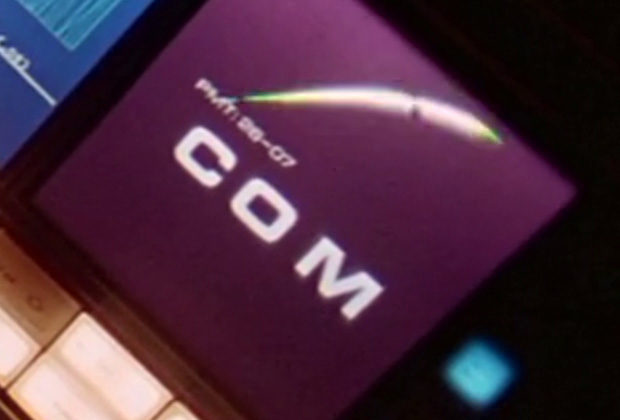
As I have suggested, this can indicate the scratches occurred on the emulsion side of the 16 mm film. A scratch on the base side usually leaves a black mark (often a black continuous line, such as when the film gets pinched in a guiding roller, for example). When a scratch occurs on the emulsion side, it can appear as a green mark (if only the magenta dye layer was removed) or a yellow one (if both the magenta and cyan dye layers were damaged), depending on the depth of the scratch. When all the emulsion has been removed – that is, all three dye layers have been scratched – the light passes right through the transparent base and the scratch appears onscreen as a white mark.

For the second sequence where the scratches are visible, we must return to DVD editions, as they appear to have been cleaned from Warner’s 2007 Blu-ray edition. Indeed, on some other editions – including the 70 mm “unrestored” prints – the scratches are visible on three additional occasions during Bowman’s rescue mission. Immediately after witnessing Poole’s murder from the command center inside Discovery, Bowman boards a second EVA pod (leaving his helmet behind) and launches a desperate (and notoriously slow) attempt to save his companion. Inside the second EVA pod, the scratches on the “COM” loop can be observed three times between the start of the mission and the moment when Bowman makes the decision to let go of his friend’s body in order to execute his “explosive bolts” plan, after being locked out of Discovery by HAL.
Throughout the mission, and in various shots, the “COM” label is still visible on the right side of the pod’s console, but in the second sequence it’s featured as the front-right computer screen, closer to the center window. Still, it runs the same two sequences: the wave-like graph and the “SLOL” dataset (as well as a “CMHK” dataset during one brief overhead shot). At five different moments during the chase, the viewer is offered Bowman’s point of view, as he tries (along with us) to locate his companion’s body in the vast emptiness of space. This shot is framed so the center of the screen is entirely occupied by the pod’s window. Only part of the front-left computer screen and part of the front-right computer screen remains visible (along with a variety of blue and yellow buttons). As mentioned, this specific shot is used five times: four times during the chase itself, and once when Bowman releases Poole’s body, watching as it floats away.
Upon closer examination, it is likely that those five scenes actually feature the same shot of the interior of the EVA pod, showing only slightly different moments during the readout of the loops. In other words, the computer displays show slightly different content from one scene to another, but it’s merely a different section of the same shot being re-used. Each time though, different content is matted into the window area of the EVA pod. The first two times the shot is used, the window is empty except for stars as Bowman looks for Poole’s body. The third time, the body can be seen as a tiny yellow dot. The fourth, the body closes in and comes in full view. The fifth time the shot is used happens after Bowman fails to persuade HAL to let him in, and he decides to release Poole’s body: it floats away, becoming smaller in the pod’s window. In those five scenes, the “COM” logo loops back on the computer display three times. Each time, the set of scratches flashes by, clearly visible. It is almost certainly the same moment of the 16 mm loop featured in the exact same shot of the pod’s interior, being re-used.

Which editions of 2001: A Space Odyssey feature the scratches?
There are a lot of different editions of 2001: A Space Odyssey. So far, I’ve been able to examine 10 different editions ranging from a 1985 VHS pan-and-scan edition all the way to the new 2018 70 mm “unrestored” print and the IMAX 15-perforation 70 mm print. A table outlining each version is provided below, indicating if the scratches are visible in the sequence involving Poole’s radar mission (Pod 1) and the sequence involving Bowman’s rescue mission (Pod 2). Since there are many different editions of Kubrick’s movie, I’ll update those notes if new information becomes available. Crucially missing from this table are reports from the laserdiscs editions (there are six of them) and the upcoming 4K UHD release (Amazon.com).
| Distribution | Year | Format | Edition | Pod 1 | Pod 2 |
|---|---|---|---|---|---|
| MGM | 1985 | VHS | no | no | |
| MGM | 1994 | VHS | Deluxe Letter-Box | yes | yes |
| MGM | 1998 | DVD r1 | yes | yes | |
| Warner | 1999 | DVD r1 | Stanley Kubrick Collection | yes | yes |
| Warner | 2001 | DVD r1 | S.K. Collection / Digitally Restored and Remastered | no | no |
| Warner | 2006 | DVD r2 | Collection S.K. / Restauré et remasterisé numériquement | no | no |
| Warner | 2007 | DVD r1 | Two-Disc Special Edition | yes | no |
| Warner | 2007 | Blu-ray rA | yes | no | |
| Warner | 2018 | 70 mm | “Unrestored” Edition | yes | yes |
| Warner | 2018 | IMAX 70 mm | “Unrestored” Edition | yes | yes |
A couple of quick notes:
- On the MGM/UA Home Entertainment 1985 “pan-and-scan” VHS edition the ratio is 4:3, meaning the sides of the film were cropped. Since the set of scratches occurs on the “COM” computer display when it is positioned on the right side of the 2.20:1 frame, it is cropped out, as is nearly half of the original 2.20:1 image.
- Warner 2001 “Digitally Restored and Remastered” DVD edition is the only one I know of where the bright set of scratches has been cleaned in both Pod 1 and Pod 2. However, a linear scratch remains clearly visible as the “COM” label passes by in Pod 1. The dual layer PAL Region 2 (R2) DVD released by Warner in France in 2006 is likely a repackage of the 2001 “Digitally Restored and Remastered” edition.
- In Warner 2007 Blu-ray edition, the set of scratches on the “COM” computer display is clearly visible in Pod 1. It is this version that is featured at the beginning of those research notes. The scratches however are not visible during Bowman’s rescue mission (i.e. Pod 2).
- The fact that the scratches are present on both missions on the 70 mm “unrestored” edition suggests that some of the original material (perhaps the original camera negative) still bears trace of them.
- The IMAX edition is based on Nolan “unrestored” edition premiered at Cannes in May 2018. I saw the IMAX 15/70 on August 31, 2018 at the Cinesphere in Toronto.
About computer readouts in 2001: A Space Odyssey
When it comes to the making of 2001: A Space Odyssey, discussions abound on the innovative methods used to create the “Dawn of Man” sequence (with its front projection and elaborate costume designs) or the “Star Gate” sequence (with its innovative use of slitscan photography). Less attention is given to the massive task of producing all the readouts seen on the computer screens featured in various spacecraft throughout the film. Yet those readouts have quite a story to tell: some even ended up being used in the production of the “Star Gate” sequence.
The fact that the production of those user interface readouts posed a huge challenge at the time might come as a surprise to modern-day audiences accustomed to computer-generated imagery (CGI). Kubrick had been advised to integrate many flat computer screens as part of the Discovery set. In his book Space Odyssey: Stanley Kubrick, Arthur C. Clarke, and the Making of a Masterpiece released for the 50th anniversary of the film, Michael Benson explains how the suggestion came from highly qualified engineers working with Bell Labs:
In the summer of 1965, Kubrick received two detailed Bell Labs reports written by A. Michael Noll, the digital arts and 3-D animations pioneer, and information theorist John R. Pierce—coiner of the term “transistor” and head of the team that built the first communications satellite. They recommended that Discovery’s communications systems feature multiple “fairly large, flat, and rectangular” screens, with “no indication of the massive depth of equipment behind them.” (2018: 125)
In April 2018, A. Michael Noll provided more details about his work on 2001: A Space Odyssey, along with PDF copies of the two reports and two original illustrations. The main report, written by John R. Pierce, is concerned (among other things) with “The Communications Center of the Ship.” In it, Pierce described how the communication center should look:
I think of the following as the essentials of the communications center on the ship. Above and in the center, at eye level, we have a TV screen used in person-to-person transmission. This will show either one’s own face, the face of the person to whom one is talking, or data when data is being transmitted or received. To the left and to the right we have alternate screens for transmission of scenes from the ship. (Memorandum: “Communications Equipment for 2001”, Bell Telephone Laboratories, June 25, 1965: PDF)

All those flat computer screens certainly provided the Discovery with a futuristic look, but they also required content. So back in 1965, the production team for 2001: A Space Odyssey knew it had to come up with quite a large volume of detailed and realistic computer readouts. The problem was that they had to find a way to produce those computer readouts without the help of computers. Benson explains the issue:
2001: A Space Odyssey was an analog-to-digital undertaking from the beginning. The projected ubiquity of computer motion graphics decades in the future had been internalized by Kubrick and his designers, but because the kind of processing power needed to drive the incoming information age wasn’t yet available, it would all have to be done by hand. (2018: 131)
Although computer graphics did exist in the mid-1960s, they had serious limitations. Kubrick had actually researched the idea. In his voluminous book The Making of Stanley Kubrick’s ‘2001: A Space Odyssey’ edited by Taschen, Piers Bizony provides further explanation:
Prior to coming to England, Kubrick paid a visit to Marvin Minsky2 at MIT. His ideas would feed into the creation of HAL 9000. Additionally, on the graphics front, he had a couple of intriguing samples to offer, based on fractal patterns […] But there were problems. First, Kubrick could not not easily gain access to the type of giant computers that were required, in those days, to produce even the simplest graphics; and second, the best screen resolution was 512 pixels across. (2015: 171)
The computer graphic animations would have to be done the old-fashioned way. As Douglas Trumbull recalls in Bizony’s book, “we had to make something that looked like computer graphics by using conventional film and animation techniques” (Ibid.). Today, Trumbull is a highly regarded special effects supervisor, renowned for his work on films such as Close Encounters of the Third Kind, Star Trek: The Motion Picture, Blade Runner, and The Tree of Life. Back in 1965 however, he was 23 years old and had barely started in the business of special effects, working mostly with illustrations. He first joined Kubrick and the pre-production team in England in mid-August. As it turns out, his very first assignment was the production of the many readouts seen throughout the film, and especially during the “Jupiter Mission” segment.
The readouts had to be entirely made using analog equipment and techniques. Each one is actually a unique analog animation first photographed frame by frame on 35 mm film, and then optically transferred to 16 mm film. On the set, 16 mm projectors were installed behind each computer screen. In this way readouts could be projected behind each screen using the well-established technique of rear projection:
Dozens of monitors and screens would be incorporated into the shipboard environment to present these visual graphics, which were rear-projected from points of concealment within the set. (Shay and Duncan, 2001: 82, 85)
Trumbull elaborates on the animation process in an essay published in the June 1968 issue of American Cinematographer3:
To produce thousands of feet of continually changing graphic readouts to cover the multitude of screens in “2001” would have been an impossibly long job using ordinary animation techniques. We terminated work with the local animation camera service, set up our own 35mm Mitchell camera with stop-motion motor, and with the help of a very talented and artistically oriented cameraman, we began the job of pasting up and juggling around artwork under the camera as we were shooting. (Trumbull, 1968: 459)
The 35 mm Mitchell camera had been “cannibalized from an optical printer,” as Don Shay and Jody Duncan explained in the seminal article they penned for Cinefex in 2001, which to this day still offers the most detailed account of the production of those readouts (2001: 85). Unlike traditional animation, the camera was fixed, and movement was simulated using a zoom.
“A lot of the readouts were generic,” further explained Bruce Logan4, the talented cameraman mentioned by Trumbull, “– nothing very carefully thought out. There just needed to be something moving on the viewscreens. Doug and I would strip up graphs and such, and then start blinking on lettering and numbers.” (Ibid., p. 85). Bruce Logan, who was just 19 at the time, would end up becoming a well-known special effects supervisor, credited (among other feats) with detonating the Death Star in the original Star Wars5.
For inspiration, the two collaborators turned to pre-existing material, looking for ways to quickly but realistically render various measurements, movements, and readings. Science magazines proved to be a valuable source of useful content:
Thousands of pages of graphs and charts xeroxed from magazines such as Scientific American provided additional readout material. “We had all these things blown up into giant pile of high-contrast negative transparencies,” said Trumbull. “We also devised a fake language – HAL’s language of numbers and letters – with strange little acronyms and three-letter words, which we typed on an IBM typewriter. We’d sit there at the animation stand cranking out enormous volumes of footage, one frame at a time. We’d shove this stuff under the stand and line it up by hand, put a red gel over it, shoot a few frames, then move it around and burn in something else or change the numbers. It was all just tape and paper and color gels.” (Shay and Duncan, 2001: 85)
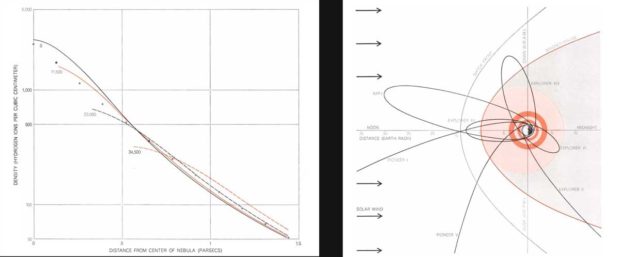
To animate those gels more efficiently, they were set on a pane of glass mounted on ball bearings. Bizony explained the process, building on materials gathered by Shay and Duncan for their Cinefex piece:
These semi-transparent elements were mounted in various combination onto a pane of glass resting on large ball bearings, so that the glass could be moved smoothly from side to side. An improvised animation camera was mounted on steel poles, with its lens pointing down toward the glass. An evenly diffused light source was positioned underneath the rig. Lateral movements of the glass, combined with colored transparent filters and gradual zoom-lens alterations on the camera, created interesting effects, as sheet after sheet of graphic elements were photographed like individual cels in a traditional cartoon animation. (Bizony, 2005: 172)
Creating readouts for all the computer displays seen through the movie required the special effects team to produce a vast number of animations:
Tens of thousands of feet of completed footage were needed for the cockpits displays in the Orion shuttle flight deck, the Aries Moonship, and the Moonbus. The Discovery sets alone required up to a dozen of screens to function simultaneously for some shots. The effect team built mechanized, electrically powered rigs that could automate at least some of the process required for the many animations. The camera controls and the rig motions were driven by an array of self-synchronizing (“selsyn”) electric motors wired to banks of electrical switches and timers nearby. Each motor operated in synchrony with the others, thereby enabling precisely controlled incremental changes in the set-up ahead of each new frame exposure. (Ibid.)
Even with this elaborate animation technique, creating all the required readouts ended up taking many months, Trumbull recalls:
In this way sometimes as much as a thousand feet of active, colorful, diagram animation could be produced in one day. Specific readouts showing docking alignments taking place, testing procedures under way, and other specific story points were not as fast and easy to shoot, however, and the job of producing all of the read-outs for “2001” took nearly a year. (1968: 459)
Mostly because of space constraints on the set, the animation had to be optically transferred from 35 mm to 16 mm (Agel, 1970: 108, 140; Shay and Duncan, 2001: 86). This allowed the team to rig all the required projectors side by side, while additionally limiting the noise and heat 35 mm projectors would have otherwise produced. The task of rigging all the 16 mm projectors, which came with its own set of challenges, was given to Brian Johnson (formerly known as Brian Johncock), a special effects artist who ended up winning Academy Awards for his work on Alien (1979) and The Empire Strikes Back (1980).6. He explained how they manage to overcome several problems in order to properly rig all the projectors for the rotating centrifuge featured in the Discovery:
There were seventeen or eighteen screens on the set; and since the whole thing rotated, we had to run everything off slip rings and with remote control of one form or another. The problem was that the set and the screens had been designed without anyone having figured out how they were going to get the projectors into place – the usual thing that happens on a big production– and there wasn’t enough room to fit all the projectors that were needed. Someone had already fashioned a system where mirrors could be used to reflect projected images onto the screens; but when the set rotated, these mirrors bounced around and it was difficult, or impossible, to get the projectors lined up. No one really had an idea of how to make it work until I suggested mounting the projectors base to base – one right-side up and one upside-down. That way we could project right onto the screens, without needing mirrors. (Shay and Duncan, 2001: 90; see also Lightman, 1968: 446; Agel, 1970: 114)
With the rigging system secured, other challenges involved exploding lightbulbs and dealing with the sound produced by 18 projectors running simultaneously:
There was a lot of bulb-changing, though, mostly because the wheel vibrated a lot and the filament couldn’t handle it. We used Bell & Howell 16mm projectors with rapid pull-down and three-bladed shutters so there wouldn’t be problems syncing up with the camera. We switched them on and off remotely. I ran some of the film forward and some of it flopped and backward to make it all wind up the right way on screen. We also had to deal with sound-proofing. Stanley wanted to shoot dialogue in the set, of course, and the projectors made quite a lot of noise. So not only did we have the problem of operating them, we had to blimp each one. I built covering for them and put fans in to extract the warm air, and it all worked reasonably well. (Shay and Duncan, 2001: 90)

And that’s why in 2001: A Space Odyssey, all the computer readouts visible throughout involve a 16 mm loop and a 16 mm projector. The same applies for the computer displays aboard the EVA pods. The fact that readouts are actually being projected in loop is clearly visible in the docking sequence of the Pan Am-operated Orion III spaceplane as it arrives at Space Station V. In their essay “Gaffes & Glitches in 2001”, Geoffrey Alexander and Thomas E. Brown explain,
When we first see the (rear-projected) control cabin readout in the Orion shuttlecraft, it shows the spin of the station relative to the Orion. When we see the Orion and the Station lined up (through a matte shot composited with stock footage of the Orion interior), the readout is still showing the same relative motion of the craft.

The “COM” display is part of a three-letter screen identification protocol along with other similar system displays, most of them using a three-letter call sign: VEH, NAV, GDE, and so on. Those displays can be seen on computer screens aboard all the spacecraft throughout the film, including the Orion III spaceplane, the Aries lb lunar lander, and the Moonbus. Some of the readouts seen aboard the Discovery are also visible in various rooms of Clavius Base during the landing of Aries lb.
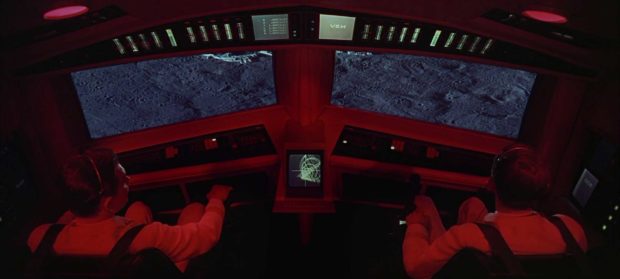
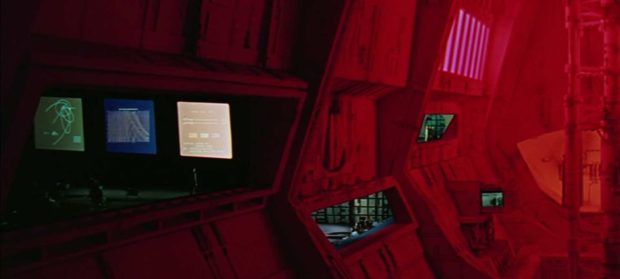

Aboard the Discovery, the “COM” computer display is part of the HAL 9000 user interface, and thus can be seen on a number of different occasions. It is featured on the main console located in the ship’s centrifuge (prominently visible in the opening shots of the “Jupiter Mission” segment). On the main console, each of the 12 visible screens is identified with a code: C1 through C12 (the numbers appear on the upper-left corner of each screen).7.

In the command center used to monitor EVAs – a location physically different than the centrifuge main console8– the screens that are visible are labeled CM1 through CM8. Each of those screens is theoretically capable of displaying anything, be it “COM” or something else. Aboard Discovery though, the “COM” display is always seen on the screen immediately to the left or right of HAL’s camera (C4 or C7).
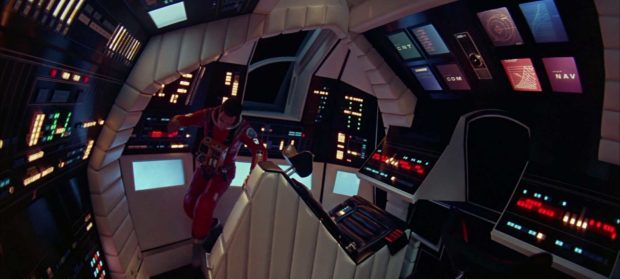
The “COM” computer display has a more important role within the Discovery, as it displays video transmissions both from Earth and cameras onboard the ship, along with pre-recorded video programs. A BBC program, The World Tonight (featuring the interview with HAL) and a message from Earth regarding the faulty AE-35 unit are presented on the “COM” display left of HAL’s camera. The birthday message recorded by Dr. Poole’s parents is also shown on a “COM” computer display embedded in the wall of the crew’s sleeping quarters in the centrifuge. The “COM” display can also play live feeds from onboard surveillance cameras, allowing both astronauts can keep an eye on each other when they take turn on EVA missions.

Those feeds were an opportunity for Kubrick to further deepen the level of realism. Some of the footage seen in the “COM” display and the two “IBM Tele Pad” (as they are labelled in the film) actually feature scenes from the set itself, where onboard computer screens are visible. Thus, on some occasions, shots of scenes where computer readouts are visible were filmed and turned into 16 mm film, then rear-projected into a display to fake a live video feed. The results are a few striking “inception” displays. For example, the BBC program featured at the very beginning of the “Jupiter Mission” segment shows the two astronauts filmed inside the centrifuge alongside HAL while there are being interviewed. Some of the computer screens from the main console with their blinking readouts are visible. The sequence just after the intermission when Bowman monitors Poole from the command center while the latter is on the EVA mission to replace the AE 35 unit also features another technically stunning display-within-display.

When it does not provide video feeds, the “COM” computer display features a set of readouts prepared by Trumbull and Logan, as I described above. Within the Discovery, the loop first features a graph labeled “BL 78” (featured prominently during the chess game Bowman plays with HAL).

Inside the EVA pod used by Bowman to first retrieve the AE-35 unit, the loop features a dataset screen labeled “ST74.” During Poole’s EVA mission to replace the allegedly faulty AE-35 unit, the “COM” screen featured the wave-like graph (immediately followed by the “COM” label where the set of scratches can first be observed). During Bowman’s subsequent rescue mission, at least three different loops are featured. Only briefly shown on the front-right screen is a “CHMK” dataset. Another, more prominently featured graphic is the same wave-like graph seen in Poole’s EVA mission (which ended with him being murdered by HAL). A third is another dataset labeled “SLOL,” which in some shots follows the wave-like graph, after the appearance onscreen of the “COM” label (the “SLOL” dataset can also be spotted inside Clavius Base, during the landing of the Aries lb).
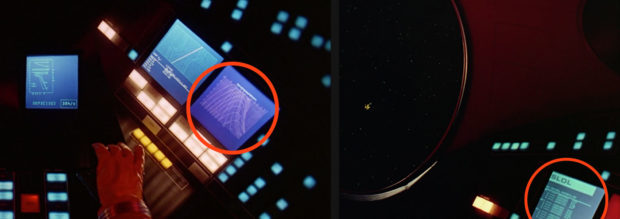
Inside the EVA pod used by Bowman, each of those loops are shown in the front-right computer screen. The set of scratches appears (and occurred) on the 16 mm loop featuring the wave-like graph. After he releases Poole’s body, Bowman directs the EVA pod toward the hatch. During his approach, the “COM” screen is featured for the longest period in the film: the sequence starts with the “SLOL” dataset, followed by the “COM” label, and then the “ST74” dataset. As mentioned before, during this long sequence the set of scratches is not visible on any copy of the film.
On only two occasions onboard the EVA pods, all the screens feature a special sequence, different from the usual readouts seen throughout the film. It is first shown when Bowman boards the second EVA pod to try to rescue Poole: the screens first show a common system initiation sequence. Finally, when Bowman’s EVA pod “lands” inside the chamber, after the “Star Gate” sequence, all the screens display the same “Malfunction” message.
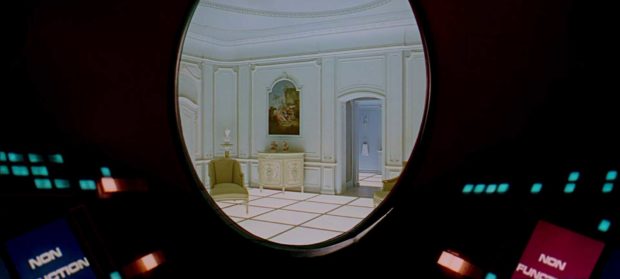
Finally, the readouts can also be seen, or rather experienced, in one additional way, independent of all computer screens. Indeed, as I suggested above, some of the materials borrowed from science magazines by Trumbull and Logan was also used to produce the colorful animation in the “Star Gate” sequence. Trumbull explained the context for this to Shay and Duncan:
“The room was painted totally black,” recalled Trumbull, “We erected our slit with a light source directly behind it. Then we built a track leading up to the slit and mounted a 65mm camera on it with a shutter that could stay open on one frame of film. To modulate the lighting coming through the slit, we used high-contrast negative transparencies that would slide behind the slit as the camera moved toward it. Some of them were very tightly controlled patterns that we photographed from books of optical art- elaborate patterns of circular lines or straight lines, bars or grids or whatever. A lot of junk from HAL’s readouts ended up in there. (Shay and Duncan, 2001: 110)
• • •
Many questions remain about the presence or absence of those scratches. Specifically, it would be interesting to learn more about what happened to Warner’s 2001 “Digitally Restored and Remastered” DVD edition and 2007 Blu-ray edition (for instance, in the latter, why are the scratches visible in one sequence and not the others). Similarly, it would be interesting to obtain information about the various laserdisc editions, at least one of which was supervised by Kubrick at the time. It should soon be possible to confirm if scratches are visible in the new, forthcoming 4K edition as well.
Further considerations will have to be developed elsewhere. For instance, what exactly are the guiding principles of restoration? To preserve the film as close to its original form? This invite discussions about faithfulness to such an original form or about the “authentic look” often mentioned in relation to recent release of the “unrestored” 70 mm edition of 2001: A Space Odyssey. It would be possible to argue there is no such thing as an “original” 2001: A Space Odyssey: indeed only interpositives (IP) and internegatives (IN) copies, and copies of copies. There might still be a single original camera negative (OCN) but it is not meant to be viewed as such, only to produce more copies. One does not watch 2001: A Space Odyssey, but watches a given copy of it. It is telling that with celluloid film, the original is called a “negative”, that it all starts with negativeness. The bright, white scratches themselves are not something we see. It is not a presence on the celluloid film, but the mark of an absence: we see the removal of all layers of dye. This removal, it turns out, further testifies of the materiality of a medium once used to simulated a digital future often perceived as being as immaterial as HAL’s disembodied voice. The stubborn persistence of this materiality into Blu-ray editions of the film further invites reconsideration about common narratives having new media replacing old ones in a clear, linear succession.

• • •
References
-
Agel, Jerome (1970). The Making of Kubrick’s 2001, 1st edition, New York: Berkley.
-
Benson, Michael (2018). Space Odyssey: Stanley Kubrick, Arthur C. Clarke, and the Making of a Masterpiece, New York: Simon and Schuster.
-
Bizony, Piers (2015). The Making of Stanley Kubrick’s ‘2001: A Space Odyssey’. Köln: Taschen.
-
Bozung, Justin (2014). “2001: A Space Odyssey Interview Series: Brian Johnson”, TVStoreOnline.com, August 21.
-
DeMet, George D. (1999). “The Special Effects Of 2001: A Space Odyssey”, 2001archive.org, originally published in DFX, July 1999.
-
Frinzi, Joe R. (2017) Kubrick’s Monolith: The Art and Mystery of 2001: A Space Odyssey. Jefferson: McFarland.
-
Lightman, Herb A. (1968). “Filming 2001: A Space Odyssey,” American Cinematographer, Vol. 49, No. 6, June 1968.
-
Logan, Bruce (2016). “Working with Stanley Kubrick on 2001: A Space Odyssey,”, Zacuto.com, February 9.
-
Morton, Jon (2014). “Starwars.com: “Bruce Logan: The Special-Effects Jedi Who Blew Up The Death Star”, StarWars.com, December 5, 2014.
-
Noll, A. Michael(2018). “First-Hand:Bell Labs and 2001: A Space Odyssey”, Engineering and Technology History Wiki, April 25.
-
Persons, Dan (1994). “2001: A Space Odyssey: Douglas Trumbull On Stanley Kubrick’s Science Fiction Epic”, Cinefantastique, vol. 25, no 3, June.
-
Schwam, Stephanie, ed. (2000). The Making of 2001: A Space Odyssey, 1 edition, New York: Modern Library.
-
Shay, Don and Duncan, Jody (2001). “2001: A Time Capsule”, Cinefex, Vol. 85, April.
-
Stork, David G. (2000). HAL’s Legacy: 2001’s Computer as Dream and Reality. Cambridge: MIT Press.
-
Trumbull, Douglas. (1968) “Creating Special Effects for 2001 A Space Odyssey”, American Cinematographer, vol. 49, no. 6, June 1968, pp. 416-420, 451-453.
• • •
Additional materials
Replicating the computer readouts in 2001: A Space Odyssey
Since at least the 90s, a number of efforts have been made to reproduce the large variety of computer readouts visible throughout the film. Earlier efforts relied on low-resolution editions of the film and details had to be guessed or made up. More recent efforts, taking opportunity of higher resolution copies, provide more accuracy. The results were turned into desktop images, screensavers, animated Flash-based website, and even oil paintings.
-
[Flash required] The HAL Project by Joe Mackenzie: “a graphic re-creation of HAL 9000, the computer from the film 2001: A Space Odyssey.” The project –the most elaborated most detailed I could find– started in 1999 and was subsequently upgraded first in 2006, and then in 2014. However, at the time of writing the project is no longer supported, likely because of licensing issues (on Facebook, the project was terminated on January 1, 2016). In its most advanced form, the project included a HAL 9000 Wallpaper Pack and a HAL 9000 Screensaver (v4.0). Free and paid editions were available. Version 4.0 of the screensaver included 84 separate animations and supported ultra-wide (21:9) aspect ratios. As of 2018, the download link for both the free and the paid versions does not work. However, previews of both the advanced and the basic edition can be examined on Daily Motion. Notice how the “COM” display correctly reads “PMT:26-07”.

Snapshot from “The HAL Project” by Joe Mackenzie (as of Sept. 3, 2018). Notice the “PMT:26-07” call signe and the “C7” computer identification label (upper left corner of the computer display). -
For his project, Joe Mackenzie was inspired by the HAL Corporation website and earlier screensaver designs by Mike L. Jackson. This earlier version stems from a project started in 1992. Its primary source material was the cropped pan-and-scan 4:3 VHS, along with Pers Bizony’s book 2001: Filming the Future and David Stork’s book, HAL’s Legacy: 2001’s Computer as Dream and Reality. At the time of writing, a preview of Jackson’s screensaver can be found online (Flash is required). The screensaver running on a TV fitted with a replica of HAL 9000 can be viewed on YouTube as well (the replica was made by Golden Armor in 2010). There is much more relevant materials to explore over at the HAL Corporation website

Snapshot of Mike L. Jackson Flash-based reproduction of “HAL 9000: USS Discovery Interface” (as of Sept. 3, 2018). The identification label for each screen (C1 through C8) is clearly visible. The number featured on the “COM” display reads “ATA 494-503”: this is made up and it does not appear in the film. -
[Flash required] The HAL 9000 by Mike Dillinger “provides an interactive experience with the world of Stanley Kubrick’s 2001: A Space Odyssey”. The home page reproduced an animated version of HAL 9000’s main console with 8 screens each randomly displaying various readouts. The “COM” display correctly reads “PMT:26-07”. A preview of the screensaver can also be seen on YouTube. Along with Joe Mackenzie’s, this is one of the most detailed reproduction there is of the computer readouts in 2001: A Space Odyssey.
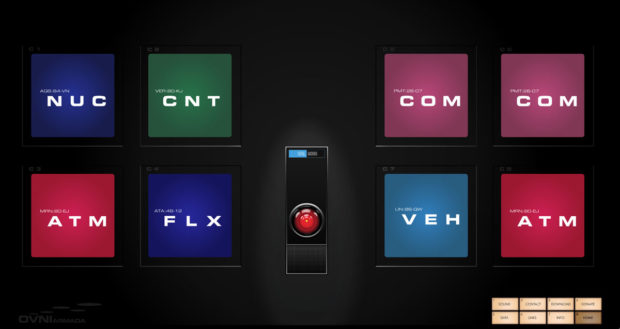
Snapshot of Mike Dillinger’s website featuring a flash-based screensaver project reproducing HAL 9000 interface (as of Sept. 3, 2018). The “COM” display correctly reads “PMT:26-07”. -
In 2008, Aegir Hallmundur recreated some of the readouts and discussed them on his blog Ministry of Type: “2008: A Type Odyssey”. In his blog post, Hallmundur explains how at the time high resolution of the readouts where hard to come buy: “Even the IMDB pages have very low resolution blurry shots that barely show the HAL console, never mind the details of what the info screens are showing. I’ve got the DVD, so a bit of stepping through frames later I can at least recreate the basic appearance of them. The small text is unreadable for the most part, but I could make a guess (that’s part of the fun).”
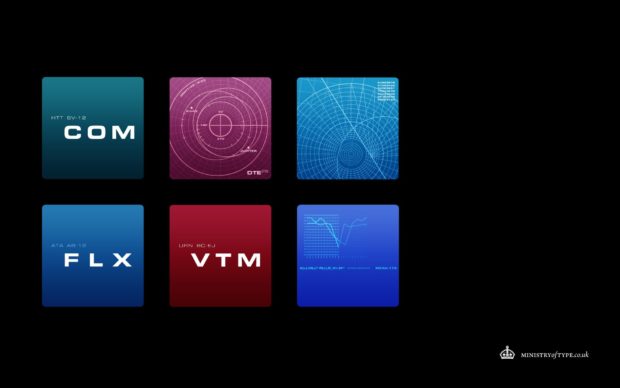
Desktop reproduction of HAL 9000 interface created by Aegir Hallmundur in 2008. Notice the call sign on the “COM” screen reads “HTT 6V-12”. This is a made up alphanumerical number and it is not featured in the film. -
The Master Replicas Group holds a “world-wide license with Warner Brothers for 2001: A Space Odyssey”. It offers “2001 Computer Art”: “The computer readouts seen in 2001: A Space Odyssey are iconic, and have influenced film design – and computer display design”. In the available preview, the “COM” screen is labeled “HHT 6V-12”: this alphanumerical call sign does not appear anywhere in the film. Piers Bizony’s book The Making of Stanley Kubrick’s ‘2001: A Space Odyssey was used as a reference. However, it appears the book edited by Taschen actually reproduced Aegir Hallmundur’s 2008 (made-up) recreation of the readouts without credit. As mentioned above, in the film the “COM” label is rather accompanied by the call sign “PMT:26-07”
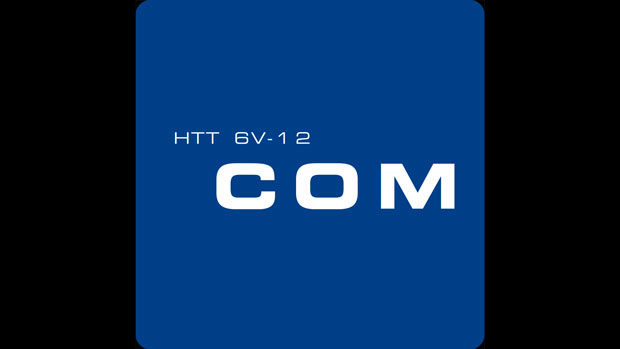
The “COM” readout, part of Master Replicas Group reproduction of “2001 Computer Art” (snapshot as of Sept. 3, 2018). 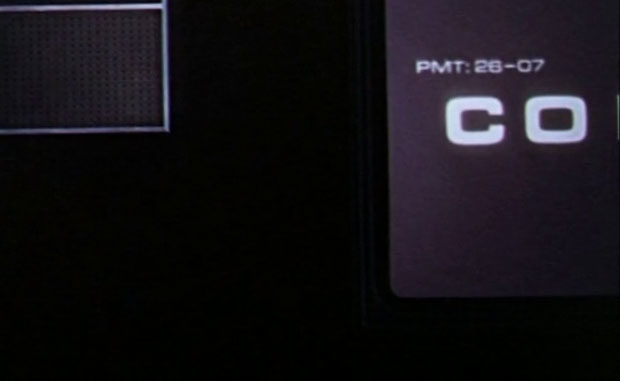
Partial detail (enlarged) of the “COM” display featuring the alphanumerical call sign “PMT: 26-07”. Snapshot Warner 2007 Blu-ray edition @01:06:16. -
American artist Damian Loeb, known for his hyperrealistic paintings, painted a set of screens based on the many screens (and their readouts) seen in 2001: A Space Odyssey. He produced the series of paintings titled D-GAMA (Screens) numbered 1 through 8 was in 2003. See Mary Boone Gallery, “Damian Loeb at Mary Boone” and “Damian Loeb: Staring Into The Abyss”. Additionally, Loeb also produced a hyperrealistic reproduction of the interior of the Discovery centrifuge: “Good Afternoon Mr. Amer” (also 2003).
-
Although not a replication project, Dave Addey writing for Typeset In The Future (which is being developed into a book) offers a close examination of typography and font choices in 2001: A Space Odyssey. Dave speculates that HAL’s own logotype diplayed in the readout “could be a manually compressed and outlined variant of Univers”.
Coudal Partner, a design studio based in Chicago offers a different guess for “the primary font in the HAL data screen”: Aldo Novarese’s 1952 Microgramma Bold Extended. Interestingly, they observed how “ten years later, Novarese reworked the idea into the more popular Eurostile.” As Dave Addey remarkes: “it’s got to the point where you can set your calendar to FUTURE simply from the presence of Eurostile Bold Extended on the wall of a passing spaceship”. The website TVTropes lists Eurostile Bold Extended as the “trope” typeset of choice for all science-fiction movies and TV shows. It specifically argues that 2001: A Space Odyssey probably first launched the trend: “The user interface for HAL 9000 in 2001: A Space Odyssey uses Eurostile Bold Extended, and is almost certainly the Trope Maker for this particular trope.”
Information about the 70 mm “unrestored” print of 2001: A Space Odyssey
The “unrestored” edition launched at Cannes in May 2018 generated interesting discussion about the “materials” that was used and about how it was handled. The specific set of scratches discussed here, as it is not accidental to any given copy of the film but most likely an integral part of the original camera negative, could become a forensic tool to distinguish between different editions.
-
“2001: A Space Odyssey: the backstage technology of a return to the big screen”, Official Cannes Festival website, May 13, 2018.
The original camera negative and soundtrack are held at the Warner Bros archive located at the studio in Burbank. The camera negative is in good condition for its age. There is some slight colour fading, which fortunately we can correct for in printing. The negative has shrunken slightly as it has lost moisture though the normal aging process. The shrinkage has caused the negative to warp slightly and cup in the centre. The negative is handled with great care as the shrinkage will also cause the film splices to come apart. The negative has been torn in four places. We decided to leave the torn frames intact and visible in the 70mm prints rather than insert a film dupe or digitally repaired section which would be of inferior quality to the original damaged section of negative.
-
2001: A Space Odyssey Special Engagement in 70 mm Film, official Warner Bros. website, 2018.
“For the first time since the original release, this 70mm print was struck from new printing elements made from the original camera negative. This is a true photochemical film recreation. There are no digital tricks, remastered effects, or revisionist edits. This is the unrestored film – that recreates the cinematic event that audiences experienced fifty years ago.” – Christopher Nolan
-
“Warner Bros. Pictures Celebrates 50 Years of Stanley Kubrick’s 2001: A Space Odyssey, official Warner Bros. press release, March 28, 2018.
For the first time since the original release, this 70mm print was struck from new printing elements made from the original camera negative. This is a true photochemical film recreation. There are no digital tricks, remastered effects, or revisionist edits. This is the unrestored film that recreates the cinematic event audiences experienced 50 years ago.
-
Turan, Kenneth (2018). “Christopher Nolan returns Kubrick sci-fi masterpiece ‘2001: A Space Odyssey’ to its original glory”, Los Angeles Times, May 03, 2018.
Through the door to share the vision come some of the people who made it possible: Ned Price, vice president of restoration at Warner, Vince Roth, technical director at the post-production facility FotoKem, and color timer Kristen Zimmermann.
-
Deb, Sopan (2018). “Christopher Nolan’s Version of Vinyl: Unrestoring ‘2001’”, The New York Times, May 11, 2018.
In 1999, as part of a preservation project, Mr. Price’s team had made an “interpositive” of the film — essentially a protection copy of the original camera negatives, made up of 20 reels tucked away in a Burbank studio. To accomplish this in less than a year, the Warner Bros. team carefully cleaned the original negatives, removed old repairs and created new interpositives. The negatives, from which the preservation copies were made, were slightly shrunken and had some color fading. That was where the work stopped. The copies of the original reels were meant only for preservation, not for distribution.
-
Tobias, Scott (2018). “Filmworker: How Leon Vitali Learned to Stop Worrying and Love Kubrick’s Dark Moods”, Rolling Stone, May 11, 2018.
“I just finished this 4K transfer of 2001: A Space Odyssey and did the color timing on this 70mm print they have at Cannes. Just because Stanley had died, it didn’t mean his principles had died, too.”
-
Morgenstern, Hans (2018). “Filmworker’s Leon Vitali on frustrating Kubrick myths and the director’s relationship with Shelley Duval – part 2”, Rolling Stone, June 11, 2018.
Even beyond Kubrick’s grave, Vitali continues to work to preserve the director’s vision. For the current re-release of 2001: A Space Odyssey (1968), Vitali color timed the 70 mm print that’s being screened in theaters. He also worked on the color timing of the 4K transfer which will be coming to home video soon.
Information about film damage, workflow and structure.
2001: A Space Odyssey was shot on Eastman Color Negative film 5251 50T stock. The following documents touch on various aspect of film damage (specifically: scratches), film workflow (to understand how new prints are being struck in relation to the original camera negatives) and film structure (layers of dye).
-
PDF: “Handling of Processed Film: Film Damage”, Kodak.
Scratches are severe examples of abrasions. They physically damage the surfaces of the film and can cause the removal of a print from service. A scratch the width of a human hair will project on a 6 foot screen almost 3/4 inch wide with super 8, 3/8 inch wide with 16 mm, and nearly 1/4 inch wide with 35 mm films. A scratch is a single definite line.
-
PDF: “Optical Workflow”, Kodak.
The interpositive is also often scanned or telecined to create the video master for home distribution.
-
PDF: “Film Structure”, Kodak.
Film is made up of layers, and it’s the combination of these layers that give each film its character. Motion picture film consists of a transparent support film base, a light-sensitive emulsion, and a number of layers coated on both sides. Some layers are different from those coated on still film and are designed to help motion picture film travel smoothly through the camera.
-
In the book The Permanence and Care of Color Photographs by Henry Wilhem (1993), the chapter “The Permanent Preservation of Color Motion Pictures” discusses the perils of color fading in motion picture film stock. Specifically, it recounts Martin Scorsese’s campaign to fix “the instability of Kodak color stock”. A letter he wrote to Film Comment in 1978 opens with those words, “How can we sit back and allow a classic film, 2001: A Space Odyssey, to fade to magenta?”
Identifying versions of 2001: A Space Odyssey
It is not always easy to properly identify a given version of the film, even when physical copies are available. While I conducted research for this article/post, the following resources were helpful:
- eBay, but also other similar classified advertisement websites. People often share hi-res photos of cases, tapes, and discs. One can even reach out to sellers and ask questions about a given copy.
- The Bibliothèque Nationale de France has a detailed listing of a number of French editions of the film.
- The “Distributors” section on 2001: A Space Odyssey IMDb page is quite extensive, although it lacks detail.
- From Visual Memory, a homage website to all things Stanley Kubrick, comes the essay “The Big Picture: 2001 on Video” by Thomas E. Brown. The essay pre-dates the release of DVD editions, but it remains the best source of information about the laserdisc editions of 2001: A Space Odyssey.
- Hunt, Bill (2001). “The Films of Stanley Kubrick on DVD” May 22, 2001.
- Tooze, Gary (2008). DVD and Blu-ray comparison, DVDBeaver.com.
Finally, at the time of writing the 1968 documentary featurette “A Look Behind The Future” was available to watch online. Among other things, it features exterior footage of the centrifuge set rotating. The featurette is part of the special edition released by Warner in 2007 (both the two-disc DVD and the Blu-ray).
• • •
1.This shot provides an example of an “inception” readout: a computer screen featuring other computer screens. This will be further discussed in the section about the making of the computer readouts used in 2001: A Space Odyssey.↩︎︎
2. Marvin Minsky was interviewed about his experience during the production of 2001: A Space Odyssey by David G. Stork (Stork, 2000: 16-31).↩︎︎
3. A reproduction of the essay as it appeared in American Cinematographer is available online. The essay was republished in Schwam’s The Making of 2001: A Space Odyssey (2000). Trumbull also speaks at length about the whole process of creating thousands of feet of animation in the June 1994 issue of Cinefantastique. ↩︎︎
4.Bruce Logan further shares his experience working with Stanley Kubrick, along with personal photographs: “Working with Stanley Kubrick on 2001: A Space Odyssey” (February 9, 2016)↩︎︎
5. See “Starwars.com: “Bruce Logan: The Special-Effects Jedi Who Blew Up The Death Star” by John Morton, December 5, 2014.↩︎︎
6. Among other special effects, Brian Johnson is behind the famous sequence in Alien where one of the creatures bursts through John Hurt’s chest. For more, see this profile over at British Cinematographer. Brian Johnson further discusses his involvement in the production of 2001: A Space Odyssey in this interview from 2014: “2001: A Space Odyssey Interview Series: Brian Johnson” by Justin Bozung for TVStoreOnline.com, August 21, 2014.↩︎︎
7. Over the years there have been a number of interesting efforts to replicate the HAL 9000 user interface and its many blinking readouts. Some of the more elaborate ones are listed in the “Additional Materials” section of this essay.↩︎︎
8.In 2013, Taschen commissioned Oliver Rennert to paint a cut-out view of the habitation sphere for Piers Bizony’s book The Making of Stanley Kubrick’s 2001: A Space Odyssey. A detailed view of the habitation sphere can be seen in a piece published by New Scientist: “The Making of 2001: How Kubrick and Clarke designed the future” by Simon Ings, August 26, 2015. ↩︎︎
• • •
Previously:
- Kubrick’s ‘Dr. Strangelove’ premiered on January 29, 1964
- Free app offers rare photos from the Stanley Kubrick Archive
- Actual Copy of Terrence Malick’s Notice to Projectionists (Tree of Life)
• • •
Bonus – Found during visual examination of the film: a single typo in the title card of the BBC show The World Tonight. There is also an extra colon mark in the line just below.
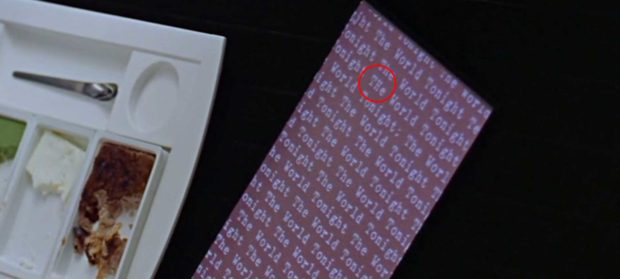
- By Philippe Theophanidis
- on
- ― Published in Communication, Movies, Technology
- Tagged: celluloid, digital, film, Kubrick, materiality, restoration, science fiction

